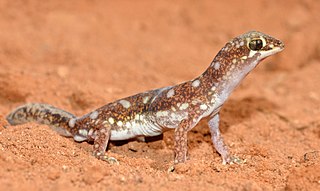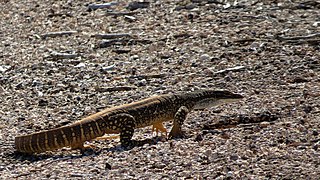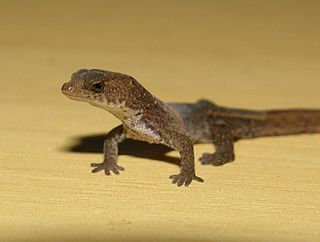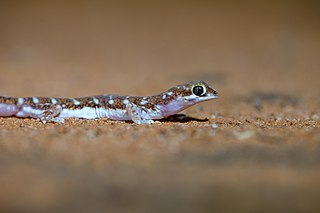Related Research Articles

Lizard is the common name used for all squamate reptiles other than snakes, encompassing over 7,000 species, ranging across all continents except Antarctica, as well as most oceanic island chains. The grouping is paraphyletic as some lizards are more closely related to snakes than they are to other lizards. Lizards range in size from chameleons and geckos a few centimeters long to the 3-meter-long Komodo dragon.

Rhynchoedura is a genus of lizards in the family Diplodactylidae. It includes six species, commonly known as beaked geckos, all of which are endemic to the arid zone of the Australian outback.
The Adnyamathanha are a contemporarily formed grouping of several distinct Aboriginal Australian peoples of the northern Flinders Ranges, South Australia. The ethnonym Adnyamathanha was an alternative name for the Wailpi but the contemporary grouping also includes the Guyani, Jadliaura, Pilatapa and sometimes the Barngarla peoples. The origin of the name is in the words "adnya" ("rock") and "matha".
Eric Rodger Pianka was an American herpetologist and evolutionary ecologist.

The sand goanna, also known commonly as Gould's monitor, the racehorse goanna, and the sand monitor, is a species of large Australian monitor lizard in the family Varanidae.

The short-tailed pygmy monitor is the second smallest living monitor lizard in the world with a maximum length of 25 cm.

The emerald tree monitor or green tree monitor, is a small to medium-sized arboreal monitor lizard. It is known for its unusual coloration, which consists of shades from green to turquoise, topped with dark, transversedorsal banding. This coloration helps camouflage it in its arboreal habitat. Its color also makes the emerald tree monitor highly prized in both the pet trade and zoos alike.
The Professor Robert W. Hamilton Book Author Award is presented annually to the best book-length publication by a staff or faculty member of the University of Texas at Austin. It is chosen by a committee of various disciplines, who in turn were chosen by the Vice President for Research at the University of Texas at Austin.

Pristurus carteri, commonly known as Carter's rock gecko or Carter's semaphore gecko, is a species of gecko, a lizard in the family Sphaerodactylidae.

The rock monitor is a species of monitor lizard in the family Varanidae. The species is endemic to Sub-Saharan Africa, where, on average it is the largest lizard found on the continent. It is called leguaan or likkewaan in some areas.

Femoral pores are a part of a holocrine secretory gland found on the inside of the thighs of certain lizards and amphisbaenians which releases pheromones to attract mates or mark territory. In certain species only the male has these pores and in other species, both sexes have them, with the male's being larger. Femoral pores appear as a series of pits or holes within a row of scales on the ventral portion of the animal's thigh.

Gehyra variegata, the tree dtella, variegated dtella or varied dtella, is a species of gecko in the genus Gehyra, native to inland Australia.

The Brazilian pygmy gecko is a species of South American lizard in the family Sphaerodactylidae. The species is monotypic in the genus Chatogekko. It grows to a maximum total length of only 24 millimetres (0.94 in). It is found in leaf litter on the forest floor, and preys on springtails and mites. The species is oviparous.

The Diplodactylidae are a family in the suborder Gekkota (geckos), with over 150 species in 25 genera. These geckos occur in Australia, New Zealand, and New Caledonia. Diplodactylids are the most ecologically diverse and widespread family of geckos in both Australia and New Caledonia, and are the only family of geckos found in New Zealand. Three diplodactylid genera have recently been split into multiple new genera.

Cnemidophorus arubensis, commonly known as the Aruba whiptail or cododo, is a species of whiptail lizard in the genus Cnemidophorus. The female and young lizards are known as Lagadishi, while the mature males are called Blóbló. This lizard species is endemic to the island of Aruba and is recognized as the most common and abundant species of lizard on the island.
Lepidosaur herbivory describes herbivorous lepidosaurs. Living non-avian reptiles form a paraphyletic group that consists of over 9,000 species of crocodiles, turtles, and lepidosaurs. The most diverse group, Lepidosauria, is first known from the Middle Triassic fossils, but likely originated in the Permian. Living lepidosaurs, which include snakes, lizards, and rhynchocephalians, occupy a wide range of environments and niches. The lepidosaurs have many similar anatomical morphology like transverse cloaca, distal tongue, superficial teeth attachment, fused pelvic bones etc. Though widely viewed as obligate carnivores, a small number of lepidosaurs are known to consume plant material. For example, there are roughly 3,300 species of living lizards and approximately 3% of them eat at least some plants. Though the exact definition of herbivory varies significantly between scientists, most define herbivorous lepidosaurs as those that consume plants for approximately 70-90% of its diet.

The border beaked gecko is a gecko endemic to Australia in the family Gekkonidae. It is known for its distinctive beak-like snout and ability to camouflage itself in its surroundings.

Ctenotus leonhardii, known by the common names Leonhardi's ctenotus, Leonhardi's skink or common desert ctenotus, is a species of skink found in a range of arid and semi-arid regions throughout mainland Australia. The species was named after German anthropologist Moritz von Leonhardi in 1919 and belongs to the genus Ctenotus, one of the largest genera of lizards in Australia.
The ipilja-ipilja, or ipilya, is a giant gecko in the mythology of the Tiwi people of Australia. He is considered to be the creator of rain and thunder.
References
- ↑ "Belah Sun Woman: III - Kundu Lizard Man".
- ↑ "Belah Sun Woman".
- ↑ Jennifer Isaacs (2005). Australian Dreaming: 40,000 Years of Aboriginal History. New South Wales: New Holland. p. 142. ISBN 1-74110-258-8.
- ↑ Pianka, Eric R.; Vitt, Laurie J. (2003). Lizards: Windows to the Evolution of Diversity. ISBN 9780520248472.
- ↑ Pianka, Eric R.; Vitt, Laurie J. (2003). Lizards: Windows to the Evolution of Diversity. ISBN 9780520248472.
- ↑ Pianka, Eric R.; Vitt, Laurie J. (2003). Lizards: Windows to the Evolution of Diversity. ISBN 9780520248472.
- ↑ Patricia Montley, In Nature's Honor: Myths and Rituals Celebrating the Earth, Unitarian Universalist Association of Congregations, 2005
- ↑ Patricia Monaghan, Encyclopedia of Goddesses and Heroines, New World Library, 01/04/2014
- ↑ "Oceanic Mythology: Part II. Melanesia: Chapter I. Myths of Origins and the Deluge".